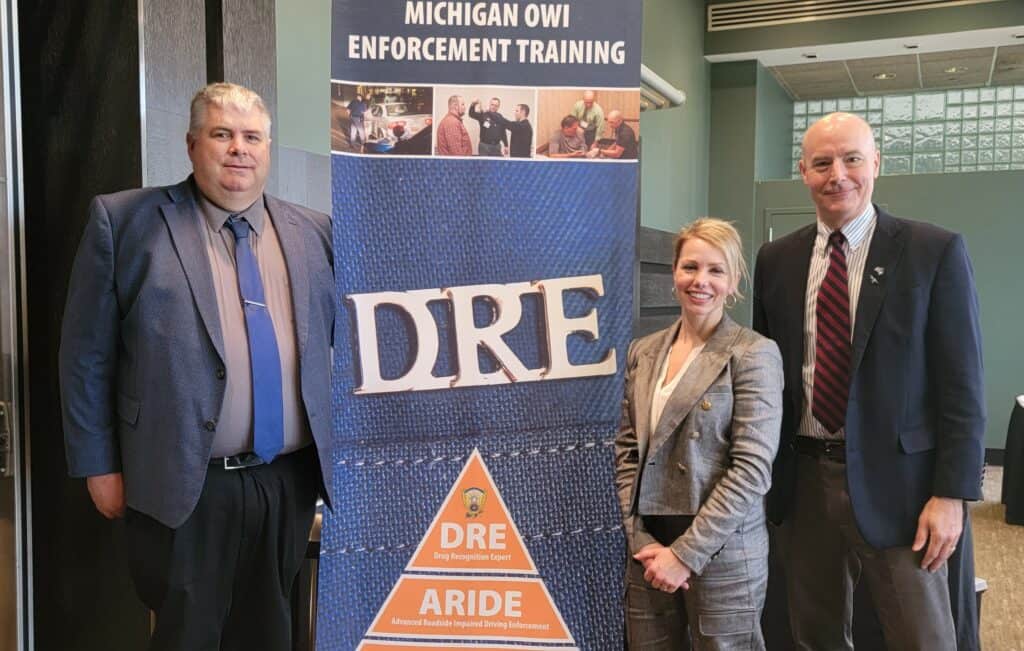I was invited to discuss my 2009 MSU Packaging PhD Dissertation, product counterfeiting, with the Michigan State Police’s Drug Recognition Expert Program. These are the top 1% of officers who are trained to identify ‘OWI – operating while impaired’ (‘DUI – driving under the influence’).
Reference: See related content in our previous blog post regarding our report on ‘Study of Product Counterfeiting by Michigan Residents — Attitudes toward Product Counterfeiting, Related Law Enforcement Priority Setting, and Internet Medicines Purchasing Behaviors.’
This presentation led me to review my intellectual property rights anti-counterfeit strategy dissertation. This also gave me an opportunity to review fraud prevention from the front line of law enforcement. Several key concepts and insights will be reviewed here.
Michigan State Police’s (MSP) Drug Recognition Expert Program (DRE)
For the state of Michigan, the Michigan State Police (MSP) coordinates the Drug Recognition Expert (DRE) Program. The training and certification are based on an international-level certification program. Beyond alcohol, the DRE officer is trained to “identify, evaluate, and document suspected drug impairment.” There is a twelve-step evaluation of the category of drug that is “most likely causing that impairment.” Alcohol and driving under the influence (DUI) are part of this program. Marijuana is a new category of regulated products that can lead to ‘operating while impaired’ along with legally prescribed medicines.
Products: from Stolen Genuine Medicines to Adulterated Street Drugs
There is a continuum of drug recognition concerns, from stolen genuine prescription medicines to counterfeit medicines to street drugs. While street drugs (e.g., cocaine, heroin, MDMA, etc.) are a focus, there are also examples of unintentional prescription drug complications. Further, there are more cases than you might imagine of street drugs that are contaminated (unintentional addition of something else, such as another drug left on a weight scale) or adulterated (intentional addition of a different drug, often fentanyl). For example, in 2022 in Michigan, there were seizures of counterfeit Xanax (a very common prescription anti-anxiety medicine) where the US Drug Enforcement Agency estimated “40% of the counterfeit Xanax had enough fentanyl to be deadly.” (Fentanyl is a powerful synthetic opioid drug.)
Supply Chains: Illicit Production, Distribution, and Marketplace
Interacting with the MSP/ DRE program is important for our research science, as it challenges us to consider more real-world applications. Specifically, I realized that our food fraud prevention work has focused on protecting genuine products in genuine supply chains and sold in genuine markets – we focus on vulnerabilities where fraudulent products can enter that secure supply chain.
At the other end of the spectrum is the police officer who finds a visibly impaired member of the public. The problem to look for here could be stolen products from the genuine supply chain, but it could also be illicit products from illicit markets. Also, while genuine products can have an intentional adulterant-substance added, this can also happen for counterfeit prescription medicine such as Xanax or even illicit products such as street drugs like heroin.
Newsworthy: New York Times Article on ‘Drug Overdose or Poisoning’
Coincidently, the same day as my presentation, there was a New York Times article, ‘Overdose or Poisoning? A New Debate Over What to Call a Drug Death.’ A person went to Mexico to buy Percocet — a prescription painkiller drug – without a prescription and for recreational use. The product contained a lethal dose of fentanyl.
This scenario demonstrates the dangerous lack of product consistency and quality control for counterfeit medicines but also for illicit street drugs. “People who sell or share drugs are usually many steps removed from those who mixed the batches. They would likely be unaware that their drugs contained deadly quantities of fentanyl.”

Ms. Kinga Canike, Traffic Safety Resource Prosecutor, State of Michigan; and Dr. Spink
Food Fraud Prevention Strategy Insight
The insight for this meeting was focused on the fraud acts of either counterfeit medicines or (I know it sounds crazy, but) illicit street drug production using adulterant-substances or contaminants from sloppy operations.
For the MSP/DRE program, there were two key insights or contributions from the food fraud prevention strategy:
- Early Warning System for global trends: as there is collaboration on food safety alerts, there is an opportunity to share new adulterant-substances or contaminants. If something occurs in a far corner of the globe, it would be good information to include in the local investigation and laboratory methods.
- Early Warning System for Suspicious Activity Reporting: specifically, the concept of the Food Fraud Suspicious Activity Report (FFSAR) can add value. Through the work with INTERPOL/Europol Operation Opson, we developed the FFSAR to create a thorough and common investigation survey. Applying some of these questions – such as checking authentication codes or taking pictures of the labels, bottles, and pills – could help crime scene investigators.
Takeaway Points
- The concepts of food fraud prevention and general product fraud prevention can apply in some ways to broader law enforcement challenges, such as the Drug Recognition Expert Program.
- Law enforcement agencies have extraordinarily complex scientific methods and investigative processes that can be applied to food fraud prevention.
- The focus of food fraud prevention research and criminology is efficient and considers novel problems, such as sharing emerging issues using the Food Fraud Suspicious Activity (FFAR) method.

